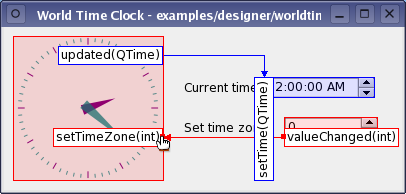Creating Custom Widgets for Qt DesignerQt Designer's plugin-based architecture allows user-defined and third party custom widgets to be edited in the same way as standard Qt widgets. All the features of the custom widgets are made available to Qt Designer, including widget properties, signals, and slots. Since Qt Designer uses real widgets during the form design process, custom widgets will appear the same as they do when previewed.  The ability to create custom widgets in Qt Designer is one of the features provided by the QtDesigner module.
Getting StartedThe process of integrating an existing custom widget with Qt Designer usually just requires a suitable description for the widget and an appropriate project file. Providing an Interface DescriptionTo inform Qt Designer about the type of widget we want to provide, we must create a subclass of QDesignerCustomWidgetInterface that describes the various properties it exposes. Most of these are supplied by functions that are pure virtual in the base class because it only makes sense for the author of the plugin to provide this information.
Two other virtual functions can also be reimplemented:
If the custom widget does not provide a reasonable size hint, it is necessary to specify a default geometry in the string returned by the domXml() function in your subclass. For example, the AnalogClockPlugin provided by the Custom Widget Plugin example, defines a default widgetgeometry in the following way: ...
" <property name=\"geometry\">\n"
" <rect>\n"
" <x>0</x>\n"
" <y>0</y>\n"
" <width>100</width>\n"
" <height>100</height>\n"
" </rect>\n"
" </property>\n"
...
An additional feature of the domXml() function is that, if it returns an empty string, the widget will not be installed in Qt Designer's widget box, but it can still be used by other widgets in the form. This feature is used to hide widgets that should not be explicitly created by the user, but which are required by other widgets. Plugin RequirementsIn order for plugins to work correctly on all platforms, you need to ensure that they export the symbols that are needed by Qt Designer. First of all, the plugin class must be exported in order for the plugin to be loaded by Qt Designer. Use the Q_EXPORT_PLUGIN2() macro to do this. Additionally, each custom widget class in a plugin that you want to be instantiated by Qt Designer must be defined using the QDESIGNER_WIDGET_EXPORT macro. Creating Well Behaved WidgetsSome custom widgets have special user interface features that may make them behave differently to many of the standard widgets found in Qt Designer. Specifically, if a custom widget grabs the keyboard as a result of a call to QWidget::grabKeyboard(), the operation of Qt Designer will be affected. To give custom widgets special behavior in Qt Designer, provide an implementation of the initialize() function to configure the widget construction process for Qt Designer specific behavior. This function will be called for the first time before any calls to createWidget() and could perhaps set an internal flag that can be tested later when Qt Designer calls the plugin's createWidget() function. Building and Installing the PluginThe project file for a plugin must specify the headers and sources for both the custom widget and the plugin interface. Typically, the project file only needs to specify that the plugin's project is to be built as a library, but with specific plugin support for Qt Designer. This is done with the following declarations: CONFIG += designer plugin debug_and_release TEMPLATE = lib When Qt is configured to build in both debug and release modes, Qt Designer will be built in release mode. When this occurs, it is necessary to ensure that plugins are also built in release mode. To do this, include the following declaration in the plugin's project file: CONFIG += release If plugins are built in a mode that is incompatible with Qt Designer, they won't be loaded and installed. For more information about plugins, see the Plugins HOWTO document. It is also necessary to ensure that the plugin is installed alongside the other Qt Designer widget plugins: target.path = $$[QT_INSTALL_PLUGINS]/designer INSTALLS += target The $[QT_INSTALL_PLUGINS] variable is a placeholder to the location of the installed Qt plugins. You can configure Qt Designer to look for plugins in other locations by setting the QT_PLUGIN_PATH environment variable before running the application. Note that Qt Designer will look for a designer subdirectory on each path supplied. See QCoreApplication::libraryPaths() for more information about customizing paths for libraries and plugins with Qt applications. Related ExamplesPlease see the Custom Widget Plugin and World Time Clock Plugin examples for more information about using custom widgets in Qt Designer. [Previous: Using a Component in Your Application] [Contents] [Next: Creating Custom Widget Extensions] |
Publicité
Best OfActualités les plus luesSemaine
Mois
Année


Le Qt Developer Network au hasard
Comment fermer une applicationLe Qt Developer Network est un réseau de développeurs Qt anglophone, où ils peuvent partager leur expérience sur le framework. Lire l'article.
CommunautéRessources
Liens utilesContact
Qt dans le magazine |
| Cette page est une traduction d'une page de la documentation de Qt, écrite par Nokia Corporation and/or its subsidiary(-ies). Les éventuels problèmes résultant d'une mauvaise traduction ne sont pas imputables à Nokia. | Qt 4.2 | |
| Copyright © 2012 Developpez LLC. Tous droits réservés Developpez LLC. Aucune reproduction, même partielle, ne peut être faite de ce site et de l'ensemble de son contenu : textes, documents et images sans l'autorisation expresse de Developpez LLC. Sinon, vous encourez selon la loi jusqu'à 3 ans de prison et jusqu'à 300 000 E de dommages et intérêts. Cette page est déposée à la SACD. | ||
| Vous avez déniché une erreur ? Un bug ? Une redirection cassée ? Ou tout autre problème, quel qu'il soit ? Ou bien vous désirez participer à ce projet de traduction ? N'hésitez pas à nous contacter ou par MP ! | ||
Copyright © 2000-2012 - www.developpez.com



















